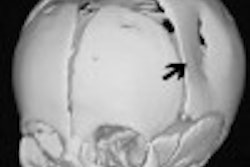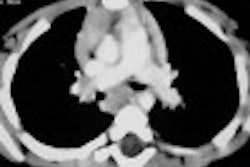"One size fits all" may be words to live by when purchasing a knit ski cap, but the adage does not hold true in PET/CT scanning. It is the application that should determine the CT configuration in combined systems, according to PET expert Dr. Homer Macapinlac.
First-generation PET/CT systems included a single-slice spiral CT scanner integrated with a PET camera utilizing bismuth germanate oxide (BGO) detectors. Over the past few years, the configurations of PET/CT scanners have changed dramatically.
A facility may select configurations ranging from a dual-slice CT scanner integrated with a high-end, high-throughput PET camera, all the way up to a 16-row CT scanner integrated with PET. Along with multiple slice configurations, PET camera detector technologies have advanced as well, with lutetium oxyorthosilicate (LSO) and gadolinium orthosilicate (GSO) cameras being offered in addition to the BGO-based systems.
"The size of the CT scanner in a combined PET/CT system depends on what you want to do and what you're doing," said Macapinlac, a nuclear medicine physician at the University of Texas, M.D. Anderson Cancer Center in Houston. Macapinlac spoke in a presentation at the 2004 Academy of Molecular Imaging conference in Orlando, FL.
"If your specialty is nuclear medicine and you're practicing nuclear medicine, then your needs may be different than those of a radiologist who also practices nuclear radiology or a nuclear cardiologist or a non-interventional or diagnostic cardiologist," he said.
The other consideration for determining CT-slice capabilities may depend on the type of practice implementing the PET/CT scanner. According to Macapinlac, a freestanding imaging center, a hospital, and an academic/subspecialty-based practice may have different needs for the modality, as well as different budgets for its purchase and support.
Numerous studies have shown that the capabilities of single- and dual-slice PET/CT scanners are superior to those of PET alone, but the configuration can make some nuclear medicine implementations tricky, Macapinlac said.
"In single- or dual-slice scanners you may have a little bit of a problem doing full-body scans in a single pass for melanoma," he said.
Breath-hold applications may also be problematic with one- or two-slice CT capabilities. This can be of particular importance for imaging patients with cancers, who may have difficulty controlling or holding their breath during an exam.
"We'll have compliant patients, at the precise moment when they need to hold their breath, who are unable to control or hold their breath. So, we may miss out on the precise anatomic localization, even with the eight-detector scanner on our PET/CT," he noted.
For radiologists practicing nuclear radiology, a PET/CT scanner can be viewed as a replacement for an outdated CT scanner, Macapinlac said. Under these circumstances, an eight- or 16-detector configuration would be able to provide standalone, high-quality diagnostic CT scanning as well as precise PET/CT imaging.
In environments where the PET/CT scanner is being utilized primarily for cardiac imaging, Macapinlac advocates the use of a 16-detector configuration.
"You want to have a very high-end or 16-slice CT scanner for cardiology applications," he said.
In general, unless a practice is going to dedicate a PET/CT for cardiac applications, Macapinlac said he believes an eight- or 16-slice CT configuration provides the greatest range of possibilities for radiologic, oncologic, and nuclear medicine PET/CT needs. He added that the next generation of CT scanners may provide an even greater boon to PET/CT systems.
"When a 64-slice PET/CT scanner becomes available, we're going to be able to have even more fun," he said.
By Jonathan S. BatchelorAuntMinnie.com staff writer
June 3, 2004
Related Reading
Use of fused PET/CT images may improve radiation targeting for lung cancer, May 25, 2004
PET/CT improves noninvasive diagnosis of cardiovascular disease, May 5, 2004
Slower CT may be better in cardiac PET/CT, March 31, 2004
PET/CT shows restaging power for head and neck tumors, March 30, 2004
PET/CT brings added value to pediatric oncology, February 27, 2004
Copyright © 2004 AuntMinnie.com



















